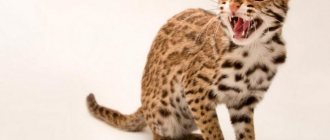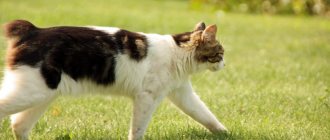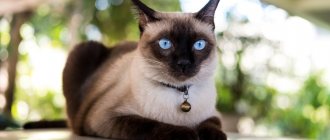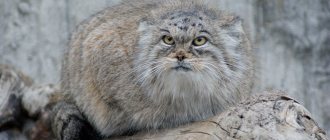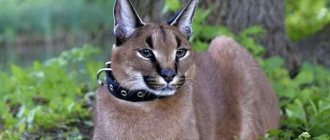On the first day of spring, March 1, Cat Day is celebrated in Russia. According to some reports, the holiday was first organized in 2004 by the Moscow Cat Museum and the newspaper “Cat and Dog”. Interestingly, many countries also have national days to honor these animals. For example, in the USA it is October 29, in Poland – February 17, in Japan – February 22. And the basis for all national Cat Days was World Cat Day, celebrated on August 8th.
The cat family belongs to the class of mammals, the order of carnivores. All cats - from the small domestic cat to the large Amur tiger - are excellent hunters. The first cat-like mammals appeared about 60 million years ago, during the Eocene era. The evolution of true cats began about 40 million years ago. Modern felines are divided by genera into cheetahs, caracals, catopumas, tiger cats, servals, lynxes, marbled cats, Asian cats, golden cats, pumas, clouded leopards, panthers and just cats, which also includes the domestic cat, a subspecies of the forest cat. The fauna of Russia includes such felines as the Far Eastern forest cat, manul, jungle cat, forest cat, common lynx, Amur tiger, Far Eastern and Central Asian leopards, snow leopard and caracal.
The Russian Geographical Society is engaged in the conservation and study of rare feline species: the Amur tiger, the Far Eastern leopard, the snow leopard, the manul and the lynx.
Amur tiger
The Amur tiger is one of the largest land predators on our planet: the body length of males reaches 220 cm, weight - 185 kg. It is also one of the smallest subspecies of tiger - about 550 individuals live in the wild. 95% of the entire population lives in the Russian Far East and 5% in China. In Russia, the Amur tiger population is concentrated in the Primorsky and Khabarovsk Territories, the Amur Region and the Jewish Autonomous Region. 20% of the Russian habitat is in nature reserves, national parks and sanctuaries - a special protection regime has been established here and animals can feel safe. The remaining 80% are hunting grounds, where the Amur tiger has to compete with hunters for ungulates. The Amur tiger is listed in the Red Book of the International Union for Conservation of Nature (IUCN) and in the Red Book of the Russian Federation.
manul2-evgeniy_mazurin.jpg
Manul. Photo: Evgeny Mazurin
Interesting Facts
- The Pallas cat looks like a typical small cat, similar in size to its domesticated relatives. The body length of males reaches 65 cm, weight can reach up to 6 kg.
- The animal does not know how to run fast, so it escapes from enemies by resorting to hiding, in which protective coloring helps it, or by hiding in a shelter - a narrow niche, hole, on a rock, on a tree.
- Pallas's cat feeds mainly on pikas and rodents: gerbils, voles, ground squirrels, hamsters, as well as partridges and chukars. Sometimes it catches young marmots, tolai hares, and small birds. The Pallas's cat obtains food mainly from ambush, lying in wait for a long time for the victim at the entrance to the hole. The main trump cards of predators are long, motionless hiding and lightning-fast throw.
- It is difficult for Pallas' cats to live in places with high snow cover. For a cat, even 20 cm of snow is already a disaster.
- The Pallas cat received its second name - the Pallas cat - in honor of the Russian and German naturalist Peter Simon Pallas, who first gave a scientific description of this species on the coast of the Caspian Sea in the 18th century.
Reproduction and care of offspring
Steppe cats prefer to lead a solitary lifestyle . Each male has his own territory, which he jealously guards from the invasion of other cats. The females also help guard the territory, settling not far from the males, and, if necessary, join their efforts to drive away the strangers.
The mating season for these animals lasts from January to March. Interestingly, unlike domestic cats, steppe cats are rather quiet creatures and try not to attract attention by screaming and meowing. Only during the mating season, these cats can make different sounds, from loud meows to snorting and growling.
A female ready for mating can be courted by several males, and she chooses the largest and healthiest male as the father for future offspring. After courtship and mating, the male leaves the female and does not take any part in raising future offspring.
The pregnancy of a steppe cat lasts from two to two and a half months. As a nest, the female builds a hole or hollow in a tree. Young females give birth to one or two babies, while more mature individuals have up to six kittens in a litter. But most often, steppe cats give birth to no more than three babies. Kittens are born blind and helpless, and for the first six months they are completely dependent on the care of their mother.
Steppe cats have a highly developed maternal instinct, and they never abandon their offspring. Two weeks after birth, the kittens' eyes open, and a month later, the babies are already covered with fur and look like a smaller copy of their parents.
The female feeds the cubs with milk for more than two months, and only after this period has passed does she begin to accustom the kittens to adult food. First, the steppe cat brings the kids small rodents caught during the hunt. As the kittens grow older, the female brings live prey to her “nest,” teaching the cubs to hunt on their own.
For two to three months, steppe cat kittens do not leave the parental den; after this period, the cubs begin to go hunting with their mother. The steppe cat takes care of its babies for six to seven months, then the matured kittens begin an independent life. Sexual maturity of steppe cats occurs a year after birth, but usually, males are ready to breed only at the age of two.
Forest cats, varieties (19 photos)
Author: Yugansk
27 January 2021 20:22
Tags: Forest cats Photographs. animals interesting nature
4686
19
We are all somehow accustomed to an ordinary cat, living next to a person for centuries. Everyone knows the familiar pet purring near a saucer of milk. But not their wild counterparts living in the forests of Eurasia and the African continent. There are several representatives of the wild cat species.
1.
0
See all photos in the gallery
Forest cats are usually slightly larger than domestic cats and are well adapted to life in the wild. Having met a handsome wild animal in the forest, you should not think that it is Vaska who has gotten lost, but let the animal go its own way.
2.
0
Decent size is the main difference between the European forest cat and once domesticated species. The length of the body can reach 80 centimeters, the weight of individual individuals, depending on the species, starts from 3 kilograms and ends at 11. The tails are also different: their length is up to 30 centimeters, “chopped off” by nature, it is quite thick and very fluffy. The longest hairs grow at the tip of the blunt tail. The paws are also larger, and the sharp claws are retracted into the “sheath” when walking. In winter, wild cats sport a thick dark coat, but by summer they change it to a lighter coat. Forest cats are usually heavily decorated with dark stripes. Their large ears are devoid of tassels, and their eyes mysteriously glow with yellow-green lights. Widely spaced ears provide the animal with excellent hearing, and the eyes are able to discern a small rodent rustling in the forest floor. Forest predators have stereoscopic vision; scientists say that these cats distinguish colors.
3.
0
Whiskers, called vibrissae, are not only an ornament to a cat's face, but also a sharp sensory organ. Subtle natural sensors will tell the cat about prey approaching at a distance favorable for hunting, and will help in “calculations” about the possibility of movement in narrow places. The inhabitants of the African continent are inferior to their Eurasian counterparts in size and weight, but their skins are painted in lighter shades.
4.
0
Norwegian Forest Cat The Norwegian Forest Cat is a fluffy beauty from Scandinavian myths. Legends describe a predator with the name “Forest Cat”, capable of running along steep cliffs. Similar Norwegian cats carried the beautiful goddess Freya in harness. In our time, the king took the beautiful animal under his personal protection, granting him the status of a national cat. For centuries, the Norwegian forest cat lived next to people, some individuals served as mousecatchers on merchant ships. This type of forest cat was even exhibited at the International Cat Show in Germany in the last century. Recognition of the Norwegian Forest Cat as a separate breed saved the subspecies from extinction. Cats were brought to Russia, and through human efforts they reached the United States. Professional breeders started breeding the breed. It has been proven that this is a Norwegian cat - the closest relative of the May Coon.
5.
0
The Norwegian forest cat is the largest subspecies, reaching a mass of ten kilograms. Strong paws allow them to run head down from almost vertical surfaces. But as your pet ages, joint problems appear. The Norwegian forest cat living in the north is better insulated than other subspecies. There is thick fluffy fur and abundant undercoat. The ears and spaces between the fingers are covered with a warming layer.
6.
0
Caucasian forest cat The Caucasian forest cat is a subspecies protected by the Red Book; it was hunted too much in the last century. Lives in the highlands of the Caucasus and Turkey. They live alone, hunt small rodents and birds, but can feast on a hare or a weakened roe deer. Typically, the Caucasian forest cat is gray in color with pronounced dark stripes, but there are also black specimens. This subspecies of the forest cat has changed the least; it does not interbreed with domestic cats. The subspecies is distinguished by its large size; the male Caucasian forest cat often reaches ten kilograms. By winter it acquires insulated fur, which allows it to hunt in mountain winter conditions.
7.
0
In Dagestan, cats have taken a liking to the river banks; the inhabitants of Georgia often go down to the sea beaches. And in the area of Batumi and Poti, the Caucasian forest cat lives in the “wet” conditions, hunting every day in rivers and walking on wet dirty grass. The local forest cats even swim in streams when hunting for fish.
8.
0
Far Eastern forest cat The Far Eastern forest cat “disguises” itself as a small tawny leopard. His light coat is evenly covered with red “leopard” spots.” This is a skilled nocturnal predator that lives in hard-to-reach places. The Far Eastern forest cat is a close relative of the Amur forest cat; sometimes they, descendants of the Bengal cat, are combined into one subspecies. The Amur forest cat is distinguished by three dark stripes stretching along its back and light sides. The body is strewn with coin spots, for which the Chinese nicknamed this subspecies “money cat.”
9.
0
Amur forest cat The Amur forest cat has inhabited the forest expanses of the Far East, its habitat extends to the Amur, the coast of the Sea of Japan, reaches Hindustan, the Malay Archipelago. Many forest cats of this subspecies live in the lands of China. Leads a nomadic lifestyle, swims remarkably well, and sometimes lives in pairs. In cold weather, predators move to lowlands not blown by the wind to escape drifts near human habitation. This forest cat gets used to humans better than others; it can be kept in an enclosure, away from strangers. The European wild cat is the most similar to the domestic cat. The same gray skin and stripes, only the fur is tall and thick. Lives in the Caucasus regions, in low mountains, in the forests of Ukraine, in European countries. Selects an area with dense forest.
10.
0
Habitats The forest cat has more than twenty subspecies living in European countries, on the territory of the Russian Federation, and is found in the Middle and Far East. The cat population lives in the forests of Ukraine, Moldova, Lithuania, the Caucasus, Norway, and some species have chosen the expanses of Scotland.
11.
0
The main habitat is beech and hornbeam forests; it can live in floodplains. Prefers lands with a temperate climate, although winter wool provides good warmth in the frosty months. Sometimes it settles on the banks of rivers and seas. Sometimes cats make a safe lair on miniature islands. But the wild cat does not like regions characterized by heavy snow drifts. You won’t find it in places with extremely low winter temperatures. If there are prolonged snowfalls that cover the forest, then free animals migrate closer to human habitation.
12.
0
However, the twentieth century significantly reduced the species number and population size of European forest cats. These animals have taken a place in the Red Books of Belarus, Moldova, and the Russian Federation. The reason was the reduction of forests, cold weather, and traps set by hunters. Sixty years ago in the North Caucasus, industrial production of animals was carried out, shot for their fur. The subspecies that lived in Dagestan have almost disappeared, due to cold winters and a reduction in the number of rodents. Now the population of the local species is being restored in the Teberdinsky and Caucasian nature reserves. Representatives of the species that lived en masse in Polesie (Ukraine) have almost disappeared, but a decent number of cats live in the highlands of the Carpathians and in the Danube floodplain.
13.
0
Lifestyle and habits The forest cat is a sybarite of the wild, preferring to hunt in the most comfortable conditions. It goes out for food in the evening or pre-dawn twilight, when the sun is about to set or rise, and the forest falls asleep or peacefully dozes before the morning awakening. The cat will not leave his shelter if it is too cold outside, it is raining or it is simply slushy and unpleasant. He will wait out the bad weather in comfort, and will go for prey when the weather clears up in the forest. The cat is the sole owner of his hunting grounds; he carefully marks the entire territory (a couple of hectares of floodplains or 60 hectares of forest), informing his brothers about the occupancy of the area. It makes regular rounds of the land, walking up to ten kilometers a day, but moves far from the borders only during the mating season. Housing for a forest cat can be a hollow, a crevice in the rocks, or a hole left by the previous occupant. The predator often changes its roosting location, choosing the most abundant food supply. In summer, animals are driven away from their favorite corner by fleas; in winter, they often change their location due to problems with hunting in conditions of high snow cover.
14.
0
Hunts with sharp jumps, instantly grabbing the prey. Excellent vision and hearing, plus signals picked up by the vibrissae, help them hunt in poor lighting, but wild cats have difficulty discerning odors. It can wait for prey near the lair or in “fishy” places. They never stock up, preferring to dine on freshly caught prey. Cats living near ponds hunt from branches overhanging the water and hide in the reeds. From such an ambush, a predator can even overtake a waterfowl. Fortunately, he knows how to swim, although he really doesn’t like getting his fluffy fur wet. He overtakes rodents running freely in trees by quickly climbing the trunk and running across the branches. In the excitement of the chase, in a dense forest, it can even jump from tree to tree. It grabs small animals with its paws, holds it tightly and bites the back of the skull with sharp teeth. The prey, which is superior in mass, tries to “mount” it and inflict a fatal wound in the neck area. The character of a wild cat is radically different from the usual cute cats. These are proud, aggressive loners, accustomed to surviving in the wild. They do not allow people to approach and do not invade the boundaries of settlements unless absolutely necessary. By nature, these cats are silent. But an aggressive attack will be accompanied by a dissatisfied hiss and howl, and courtship play will be accompanied by an inviting meow.
15.
0
Sometimes they try to place a forest cat at home, making it a cute pet. You can try to house a predator like an exotic toy in the enclosure of a country mansion, but it will simply destroy the apartment. Plus, we must take into account that this is a nocturnal resident, marking its territory. In captivity, it will live a long time (up to 30 years), especially if the usual diet is provided. But he won’t become a fluffy, loving ball. Individuals taken as kittens partially lose their natural talents as hunters. But people are still distrustful. He will get used to the family (having first tried to take the main place in the house), but he absolutely cannot stand strangers. He will also not tolerate other representatives of the fauna near him; domestic cats will become his first rivals.
16.
0
Diet In terms of food, the forest cat is also a gourmet and a glutton: he prefers to eat fresh prey; his daily diet can consist of a dozen small rodents. An adult can consume up to a kilogram of food daily. The victims of cats are: voles dormouse partridges pheasants coots gray rats muskrats trout nutria rabbits moles squirrels shrews weasels martens lizards Once upon a time, cats living in the steppe regions caught bustards and even eagles; sometimes a large individual can defeat a small roe deer. Predators living on the banks of rivers and the inhabitants of floodplains hunt for fish and aquatic animals. When approaching human habitation, cats free the surrounding area from the rodents that have settled there. While helping people in this way, they are doing harm at the same time by eating poultry. They cause harm to wildlife by destroying rare birds in protected areas (for example, in the Caucasus).
17.
0
The meal process resembles that of an ordinary cat, but the front paws do not fall to the ground. It chews its prey, biting off one piece at a time, starting from the side of the carcass.
18.
0
Reproduction In this regard, the forest cat can be safely called a March cat. This month marks the height of the mating season for the feline inhabitants of the forest. Only during this period do cats move away from carefully marked personal areas in search of a mate. A couple is sought for one season; a potential partner is attracted by screams and meows. After parting, the male returns to his lands and is not at all interested in the offspring. The expectant mother looks for a secluded place and prepares for childbirth, lining it with the gifts of the forest. The female gives birth two months after communicating with the cat. Usually this is the end of April or the beginning of May. A litter can have from two to seven kittens, with three or four kittens being the norm. Blind and deaf helpless lumps need maternal care (the eyes open from the ninth to the twelfth day). The female takes care of the kittens for a whole month, not being able to move far from the den. Babies drink milk for four whole months, but after the first month they are already trying to look out of the house in order to begin exploring the world. The most curious and careless kittens often get caught in the teeth of martens and birds of prey.
19.
0
Babies get rid of their baby teeth between the fifth and eighth months of life. In the second month of life, the mother begins to teach the important science of survival. Teaches how to hunt. And they become sexually mature before they are one year old. The forest cat is a beautiful and graceful predator. Accustomed to living in splendid isolation in the wilderness, high in the mountains or on the banks of rivers. He does not like people, approaching housing only during the difficult months of complete lack of food. For relaxation and reproduction of offspring, he chooses a ready-made living space, slightly arranging it. Depending on its habitat, it has a varied diet: from trout to roe deer. It deftly attacks prey, lies in wait for rodents, and runs along branches after squirrels. The beautiful animal occasionally finds itself in the role of a pet, but it copes with this mission very poorly, its instincts and habit of a twilight lifestyle take its toll. Coupled with a bad disposition, they make him not the friendliest animal. So it is better to leave it alone in its natural habitat. An exception can be considered the Norwegian forest cat, raised by breeders, and the well-tamed Amur forest cat.
Source:
Related links:
- How does a moose spend the winter?
- How a mongoose creates a mud vest against snake bites
- 6 interesting facts about the primate with the unusual nose
- 7 interesting facts from the life of the polar fox
- Strange and funny photos from the world of wildlife that raise many questions
Tags: Forest cats Photographs. animals interesting nature
Did you like the post? Support Chips, click:
156 5 151
Liked
151 3
8
Partner news
Modern classification of wild cats
Once upon a time, all cats were divided into three subgroups. Nowadays, zoologists divide wild cat families into large and small cats. Previously, the cheetah subfamily was distinguished, but then, as a result of a study of the DNA of these animals, it was determined that they are close to small cats. Each subfamily contains several genera, which differ in habitat, size, color, and habits.
Subfamily of small cats
This group of mammals is divided into 12 genera and almost 30 different species. A distinctive feature of representatives of this subfamily is the ability to rumble when inhaling and exhaling. Representatives of some species can reach two meters in length.
Small cats have enviable eyesight, excellent hearing and a good sense of smell. These predators feed on small mammals, such as rodents, and birds.
Cheetah and caracal
Cheetahs are the fastest cats in the world: they can reach speeds of up to 120 km/h. True, an animal can run so fast for only a couple of minutes. This type of cat has a long body - about 140 cm. The color is sandy with characteristic spots.
Caracal
Caracal, or, as it is also called, steppe lynx. The body length of this animal can reach up to 82 cm. Distinctive features of the caracal are the presence of tassels on the ears, as well as hair brushes on the paws. It is very agile and can jump deftly.
irbis-mihail_semenov.jpg
Snow leopard.
Photo: Mikhail Semenov In 2010, the Russian Geographical Society supported the grant project “In the Footsteps of the Snow Leopard.” Its goal is to study the state of the snow leopard population, its numbers and age-sex structure, as well as key habitats. These data will help solve the problem of optimizing the territorial protection of this species, as well as the ecosystems of Southern Siberia as a whole. In 2012, the project “In the Footsteps of the Snow Leopard” grew into a full-scale project “Wild Cats of Southern Siberia” to study and preserve rare species of cats in the south of Siberia - snow leopard, manula and lynx.
Manul
The Pallas's cat is a predatory mammal of the cat family, one of the least studied wild cats in the world. Pallas's cat is widespread in Central and Middle Asia, from Southern Transcaucasia and Western Iran to Transbaikalia, Mongolia and Northwestern China. Within Russia, Pallas's cat is found in the Chita region, Buryatia, Tuva and Altai. Included in the Red Books of the Russian Federation, the Trans-Baikal Territory, as well as the republics of Tyva and Buryatia. Manuls can be seen in the Sayano-Shushensky, Khakassky, Daursky nature reserves. The exact number of the species is unknown due to the secretive behavior of the Pallas's cat and the patchy nature of its distribution. Pallas's cat is listed in the Red Book of the Russian Federation, the IUCN Red List and Appendix II of the CITES Convention.
Manul
Pallas's cat (Otocolobus manul, Pallas's cat) belongs to the subspecies of small cats and is included in the Red Book because it is an endangered animal. The beautiful thick fur of this predator (up to 7 cm in length) of gray or reddish-brown color with silver tips has made it a desirable prey for hunters for valuable fur. This fur saves animals from frost in their natural habitats. This species of feline hunts birds, hares, marmots, mice, badgers, lives for about 10 years, weighs about 5 kg with a length of 65 cm, and reproduces in the spring.
If you are seriously considering bringing a Pallas's cat into your home, check out the arguments against it:
- Manul is a nocturnal hunter, so he won’t let you sleep at night.
- This type of cat loves space; it is not suitable for keeping in an apartment; it needs a large yard.
- Sheds heavily.
- While playing and sharpening its claws, the animal will ruin all the furniture and curtains in the house.
- He has an aggressive character; neither other pets, nor you, nor your children will get mercy from him.
- It is unlikely that you will be able to find a cat to mate with, or vice versa, and the hormones playing in the spring will drive him into rage and severe aggression.
- Veterinary medicine is not very familiar with Pallas' cats, so in case of illness, it is unlikely that you will be able to find a veterinarian who can cure it.
- You will have to think carefully about the cat’s diet so that he does not get sick and develops properly; regular cat food will not suit him.
- This animal is listed in the Red Book, therefore it is not sold legally, and an illegally imported cat is very expensive (up to 6.5 thousand US dollars), may be infected with some disease or exhausted and exhausted.
There are several reviews on the Internet of people who have domesticated Pallas's cat, but they all note the evil nature of the animal.
svetlana-sutyrina-amurskiy-tigr-2.jpg
Amur tiger. Photo: Svetlana Sutyrina
Interesting Facts
- The Amur tiger lives in low mountains, preferring river valleys and wide valleys between ridges, covered with forest.
- The tiger is omnivorous. He can eat both a frog and a bear. However, in the wild, Amur tigers prefer to feed on ungulates: deer, wild boar, roe deer and musk deer. For adequate nutrition, one tiger needs about 50–70 ungulates per year. At the same time, a tiger can eat up to 35 kg of meat in one go.
- A tiger can jump 5 m upward and 10 m long.
- A tiger's tail is a kind of indicator of its mood. When the tiger is calm, the base of its tail is lowered and the end is curved smoothly upward.
- The span of a tiger's whiskers roughly corresponds to the width of its body. Thanks to its whiskers, the predator is able to determine the nature of the surface, temperature, and wind direction. The animal is guided by its whiskers when moving in the dark.
Since 2010, the Russian Geographical Society has supported the Amur Tiger project. Its goal is to study the state of the Amur tiger population and develop scientific foundations for the conservation of the animal. In 2013, on the initiative of the President of the Russian Federation, Chairman of the Board of Trustees of the Russian Geographical Society, Vladimir Putin, the Society became the founder of an autonomous non-profit organization. Its activities focus on the fight against poaching, scientific analysis of the state of the Amur tiger population and ecosystems in the animal’s range, and the organization of educational and educational events.
Far Eastern leopard
The Far Eastern leopard is the rarest subspecies of the cat family on Earth. Currently on the verge of complete extinction. According to various estimates, about 80 individuals live in natural conditions. At the same time, most of the population lives in Russia in the Primorsky Territory and a smaller part lives in China. About 70% of the rare predator's habitat is protected by the Land of the Leopard National Park. In the 20th century, the species was listed in the IUCN Red Book, the Russian Red Book, the IUCN Red List and in Appendix I to the Convention on International Trade in Endangered Species of Wild Fauna and Flora (CITES).
The largest wild cat
Liger Hercules Among the wild representatives of the cat family, lions and tigers are considered the largest. These predators can grow up to 250–280 kg. The most impressive size feline known to mankind is the liger Hercules. Ligers are hybrids obtained from lions and tigresses (hybrids - cubs of tigers and lionesses are called tigrolves). Hercules lives in Miami Park. Thanks to its size, the cat was included in the Guinness Book of Records. The weight of this giant is 408 kg.
How does a manul live and what does it eat?
Pallas's cat lives in fairly harsh climatic conditions, with low temperatures and sudden changes in weather. The Pallas's cat prefers low snow cover, as its short legs do not allow it to move through deep snow. Therefore, the wild cat Pallas's cat is most numerous in areas with little snow.
Pallas's cat lives in steppes and semi-desert areas of mountains, choosing places with thickets of bushes, the presence of stone deposits and rock cracks. In the mountains, the manul cat rises to 3-4.5 km above sea level. It is rare in lowlands and forest belts.
The Pallas' cat lives sedentary and solitary, usually being active at dusk and early in the morning. During the daytime, he sleeps, hiding in a shelter. The wild manul makes its shelter under stones, in old burrows of marmots, foxes and badgers, as well as in small caves and rock crevices. The Pallas's cat is a territorial predator that jealously guards its territory and does not like guests, so it expels any unwanted visitor.
The color of the Pallas cat serves this wild cat as a kind of camouflage, which helps him in hunting and allows him to remain unnoticed by prey. However, the manul cat is one of the most clumsy and slow representatives of the cat family. But excellent eyesight and hearing allow him to be a skilled catcher.
Pallas's cat feeds on various mouse-like rodents and pikas. Occasionally, Pallas's cat feeds on hares, birds, gophers and marmots. Manul catches its prey by cunning. He waits for her at the hole or watches for the victim, hiding near the stones, after which he attacks, making a sharp lunge. This wild cat is very careful when hunting. Pallas's cat is not able to run fast, so chasing prey is not his strong point. In summer, the Pallas's cat feeds on various large insects, in case of a shortage of rodents.
Despite its harsh appearance, the Pallas's cat is not aggressive. Pallas's cat has practically no enemies; only wolves and large birds of prey pose a danger to this wild cat. The animal Pallas' cat is not one of those who is in a hurry to start a showdown and repel the enemy. This cat is trying to flee and lie down in a shelter. But when the Pallas cat is caught by surprise and there is no escape route to the shelter, then he begins to snort menacingly and bares his sharp teeth.
Varieties
Today, three subspecies of this steppe cat are known:
- Siberian or nominal. It lives in the northern part of its range. Has a gray color.
- Central Asian, who lives in Afghanistan, Turkmenistan, and Northern Iran. Distinguished by red fur.
- Tibetan - with darker fur, black stripes on the tail and body and brighter spots on the head. Lives in Northern India, Northern Pakistan, Tibet, Kyrgyzstan, Uzbekistan.
Brief description of the Caucasian forest cat
The Caucasian subspecies is one of the largest. Adult males weigh 6-11 kg, females are somewhat lighter - 4-10 kg. The body length is 63-75 cm, it is strong and stocky. Powerful paws are equipped with sharp long claws, allowing the animal to easily climb trees.
Coarse black hair grows between the paw pads. The tail is large and thick, as if cut off at the end; in a male it can reach 60% of the total body length. The head is wide, rounded, the ears are neat and erect.
The eyes are large, expressive and very serious. The color is mostly yellow-olive. Looking into the eyes of this creature, it is immediately clear that this is a wild animal, with habits more similar to their large brothers tigers, leopards and lions than to a cute domestic cat.
The color is predominantly gray, sometimes ocher. A black stripe appears along the forehead and along the ridge. The sides may also have dark lines, and the lighter belly has small dark spots. The rich fluffy tail is decorated with 3 to 8 black rings. In winter, the coat becomes thick, lush and longer.
The largest forest cat can produce the usual hoarse meowing sounds for a cat, but their tonality is much lower, with a more pronounced emotional coloring.
Wild forest cats are excellent hunters and merciless predators, they are cunning and cautious. This is what allows them to survive in the natural environment.
Who is considered the smallest of the wild cats?
Rusty cat The smallest wild cat lives in Sri Lanka and South India. This breed is called a red or rusty cat. Kids prefer to stay close to trees all the time. Among the dense branches they find food for themselves - bird eggs, insects, chicks. The size of a miniature cat is only 80 cm including the tail. Red predators weigh no more than one and a half kilograms.
rys-dmitriy-vahrushev.jpg
Lynx.
Photo: Dmitry Vakhrushev In 2012, the Russian Geographical Society grant project “In the Footsteps of the Snow Leopard” grew into a full-scale project “Wild Cats of Southern Siberia” for the study and conservation of rare cat species of southern Siberia - snow leopard (irbis), manula and lynx. The project is aimed at increasing the effectiveness of environmental protection measures in specially protected natural areas of Southern Siberia - these are the Khakass and Sayano-Shushensky nature reserves, the Ubsunurskaya Kotlovina state nature reserve and the Pozarym state nature reserve of federal significance. Among the objectives of the project are studying nutrition, monitoring the food supply and conducting a zoological and veterinary examination of natural populations of wild cats, as well as increasing the level of public knowledge about the need and importance of preserving rare species of animals.
Author: Anna Sokolova
Pampasskaya
This cat is also called the grass cat (Leopardus pajeros), lives in nature in the steppes of South America, is similar in size to its domestic relative, but looks larger. She has long hair (up to 7 cm) of gray, yellow or brown color, black or dark ears, a thick and long tail, and large ears.
Reasons why it is better not to keep her at home:
- The Pampas cat does not allow anyone into its territory.
- Leads a nocturnal lifestyle.
- Little studied.
- Prefers privacy.
- He steals all the birds from his neighbors.
- Doesn't adapt well to domestication.
- Listed in the International Red Book.
- The cost is about 1,000 US dollars.
Description of Pallas's cat
The description of the Pallas's cat can begin with its appearance. The Pallas cat looks similar to a regular cat, only larger and fluffier. The dimensions of the Pallas's cat range from 50 to 65 cm with a tail length of up to 30 cm. The Pallas's cat weighs from 2 to 5 kg. The wild manul cat differs from an ordinary cat in its more massive body, short strong legs and very thick six. By the way, six Pallas' cats can reach a length of 7 cm. The Pallas cat has the fluffiest and thickest fur among cats.
In the description of the manul, it should be noted that this cat has a rather angry appearance, which makes it very memorable. The Pallas's cat looks stern due to the peculiar “whiskers” on its cheeks, which are formed by tufts of long hair. The Pallas' cat animal has a wide, flattened head and small, widely spaced, rounded ears. Pallas' cat's eyes are very expressive and yellow in color.
Surprisingly, the pupils of these cats’ eyes, unlike the pupils of a domestic cat, do not narrow in bright light, but remain round. The wild Pallas cat has a long fluffy tail with a rounded tip. The color of the Pallas's cat is combined and is represented by the colors of light gray and yellowish-brown.
Manul looks unusual. Since the ends of the hairs of its fur are painted white, it seems as if the Pallas' cat's fur is dusted with snow or covered with frost. The back of the body and tail have narrow transverse stripes of a dark color. Black stripes stretch from the corners of the eyes and along the sides of the muzzle, and there are specks of dark color on the forehead. The lower part of the animal's body is brown with a white coating. The tip of the tail is colored black. The manul cat has sharp teeth and claws.
The Pallas cat animal has a very specific appearance. It is believed that this cat is related to Persian cats. The wild manul cat was discovered by the German scientist Peter Pallas, who in the 18th century conducted research on the coast of the Caspian Sea. It was in his honor that the manul received the name “Pallas cat”.
The most beautiful "savages" from the cat family
Jaguar The question of the most beautiful cat living freely in natural conditions is controversial, because all of these animals have an attractive appearance.
Photos of these predators are placed in nature magazines, on advertising posters, T-shirts, and on the covers of notebooks and notebooks. Spotted jaguars, rare American predators, unique black panthers, handsome tigers - these cats are found everywhere in the form of prints and in pictures. Share with friends!
Sumatran cat
- Length (with tail): up to 70 cm.
- Weight: up to 2.8 kg.
The Sumatran or flat-headed cat (Prionailurus planiceps) lives in Southeast Asia. The combination of large eyes and small ears gives this multi-colored cat an unusual appearance. However, the cute face hides many fangs, which are much longer than you might imagine. The predator uses them to subdue prey - squirming fish and other slippery aquatic life found in the forests of Sumatra, Borneo and the Malay Peninsula. A 2010 study found that more than 70 percent of the Sumatran cat's habitat has been destroyed by human settlement and agriculture. Researchers expect the cat's population to decline as habitat loss continues. Wildlife conservationists don't have much time left to save the flat-headed cat.
Interesting Facts
Many sites write about supposedly another breed of Chinese cats, Maneki-neko, a symbol that brings happiness. In fact, this figurine, which is often made of porcelain or ceramics, came from Japan, not the Middle Kingdom, and looks like a cat waving its paw. It is sold in souvenir shops and is believed to bring prosperity and happiness to the home.
The history of Maneki-neko began in the early 17th century, when one poor monk sheltered a wild mountain kitten dying of hunger. The temple in which the man lived was in a terrible state. One day, out of melancholy and hopelessness, the monk spoke to the animal, saying that he did not blame him for being useless, but if the cat were a person, he could be more useful.
The next day a thunderstorm broke out. A prince was driving past the monastery and saw a Chinese cat on the road waving its paw. The beast showed the way to the shelter, where the traveler found food and shelter. The next day, a wealthy guest allocated funds for the restoration of the monastery.
Since then, Maneki-neko has been in every home and it is believed that happiness and good luck always follow it.
Kalimantan cat
- Length (with tail): up to 58 cm.
- Weight: up to 4.5 kg.
The Kalimantan cat (Catopuma badia), native to the island of Borneo, is so elusive that it took more than a hundred years before researchers were able to study this individual in detail. Covered in bright, rusty red fur with white stripes under the tail and face, this cat was officially discovered in 1874 based on a skull and skin sent to England by the famous naturalist Alfred Russel Wallace. Naturalists didn't have the opportunity to study the living cat until 1992, when it was finally captured. Scientists know little about how this secretive creature actually lives. Because the cat is so difficult to find, conservationists consider it an endangered species. This makes learning even more difficult. Deforestation in Borneo could wipe out the Kalimantan cat before scientists have a chance to learn more about it.
History of the species
Scientists believe that the Forest Cat appeared in the Pleistocene era, which began more than 2.5 billion years ago and ended 11.7 million years ago. Considering that humanity is only 2.8 billion years old, wild cats are at least 9 years older than humans.
The end of the Pleistocene era is characterized by an incredibly harsh climate. The planet had just experienced an ice age, the ice masses were retreating reluctantly, weather conditions also changed in waves - periods of sharp warming alternated with periods of the onset of very cold air masses. These processes served as an impetus for the transformation of flora and fauna. It was at this time that the woolly rhinoceros, mammoth, giant deer, cave lion and many other species appeared, most fully adapted to harsh climatic conditions.
With subsequent global warming, most animals of the glacial and post-glacial periods were unable to mutate and became extinct. The cat, which went into the shady forests and mountain ranges, managed to survive.
Thus, we can only talk about the approximate, latest date of the emergence of the European forest cat as a species - 11.7 million years ago. Although, most likely, this animal is older and has survived to this day since the Ice Age without any special changes.
The domestication of cats occurred much later, about 10 thousand years ago, when people began to lead a sedentary lifestyle, build homes, develop agricultural land and stockpile food.
Nutrition and lifestyle
The Caucasian forest cat leads a secretive, isolated lifestyle, intersecting with its own kind only during the mating period. Wild cats, like most of their close relatives, are territorial animals.
Each individual has a territory of 2-3 km², which they guard and periodically mark. Migrations occur only in the event of a scarce food supply and human intervention.
Forest cats prefer to settle in rock crevices, hollows and other people's abandoned holes. Man and his home are shunned. However, there are known cases when a wild cat settled within rural farms, exterminated small rodents in the area and stole poultry.
In mountain deciduous forests, these cats hunt lizards, rodents, small birds, and in rare cases they can attack muskrats, nutria, and young ungulates. The diet also contains some herbs and roots, fish, insects, and fresh carrion.
The forest cat is most active at night, but in the summer it can hunt during the day. This predator prefers to sit in ambush and attack its prey by surprise, and sometimes openly gives chase, for example, when hunting a hare.
Nature has endowed it with a gray-brown color, which blends with the color of fallen leaves and trees and makes it almost invisible. The wild Caucasian cat climbs trees well and swims well, but only gets into the water if absolutely necessary.
Southern tiger cat
- Length (with tail): up to 90 cm.
- Weight: up to 2.5 kg.
The existence of the small spotted southern tiger cat (Leopardus guttulus) was not known until 2013. The key to its discovery was genes...
Found in the rainforests of Southern Brazil, Leopardus guttulus was thought to be a subspecies of the adorable cat called Oncilla. But DNA research showed that tiger cats did not interbreed with the Oncilla population. Despite their external similarity, they were recognized as a separate species.
We are so used to admiring our pets that we sometimes forget about their counterparts living in their natural habitat. Wild cats, photos and names of which we presented in the article, are no less charming. But just don’t try to squeeze them: you may end up without fingers!
